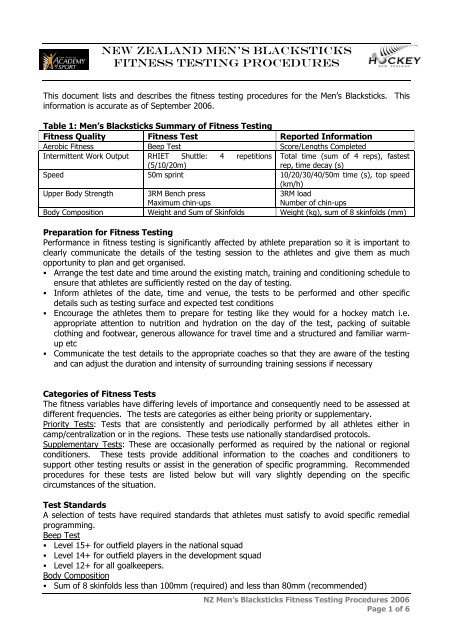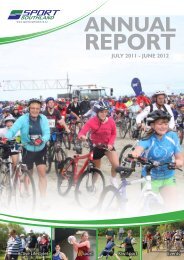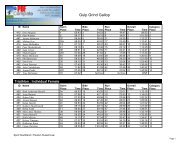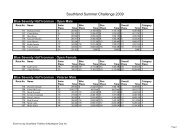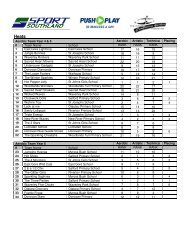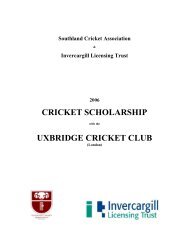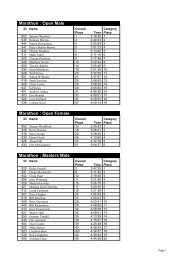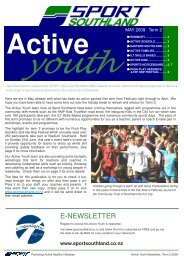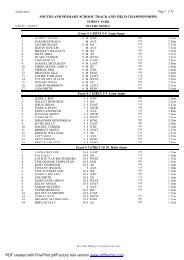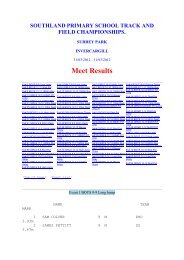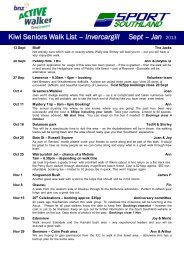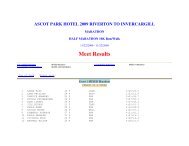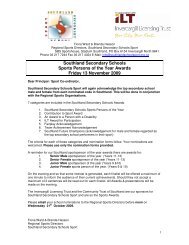NEW ZEALAND MEN'S BLACKSTICKS
NEW ZEALAND MEN'S BLACKSTICKS
NEW ZEALAND MEN'S BLACKSTICKS
You also want an ePaper? Increase the reach of your titles
YUMPU automatically turns print PDFs into web optimized ePapers that Google loves.
<strong>NEW</strong> <strong>ZEALAND</strong> MEN’S <strong>BLACKSTICKS</strong><br />
FITNESS TESTING PROCEDURES<br />
This document lists and describes the fitness testing procedures for the Men’s Blacksticks. This<br />
information is accurate as of September 2006.<br />
Table 1: Men’s Blacksticks Summary of Fitness Testing<br />
Fitness Quality Fitness Test Reported Information<br />
Aerobic Fitness Beep Test Score/Lengths Completed<br />
Intermittent Work Output RHIET Shuttle: 4 repetitions Total time (sum of 4 reps), fastest<br />
(5/10/20m)<br />
rep, time decay (s)<br />
Speed 50m sprint 10/20/30/40/50m time (s), top speed<br />
(km/h)<br />
Upper Body Strength 3RM Bench press<br />
Maximum chin-ups<br />
3RM load<br />
Number of chin-ups<br />
Body Composition Weight and Sum of Skinfolds Weight (kg), sum of 8 skinfolds (mm)<br />
Preparation for Fitness Testing<br />
Performance in fitness testing is significantly affected by athlete preparation so it is important to<br />
clearly communicate the details of the testing session to the athletes and give them as much<br />
opportunity to plan and get organised.<br />
• Arrange the test date and time around the existing match, training and conditioning schedule to<br />
ensure that athletes are sufficiently rested on the day of testing.<br />
• Inform athletes of the date, time and venue, the tests to be performed and other specific<br />
details such as testing surface and expected test conditions<br />
• Encourage the athletes them to prepare for testing like they would for a hockey match i.e.<br />
appropriate attention to nutrition and hydration on the day of the test, packing of suitable<br />
clothing and footwear, generous allowance for travel time and a structured and familiar warmup<br />
etc<br />
• Communicate the test details to the appropriate coaches so that they are aware of the testing<br />
and can adjust the duration and intensity of surrounding training sessions if necessary<br />
Categories of Fitness Tests<br />
The fitness variables have differing levels of importance and consequently need to be assessed at<br />
different frequencies. The tests are categories as either being priority or supplementary.<br />
Priority Tests: Tests that are consistently and periodically performed by all athletes either in<br />
camp/centralization or in the regions. These tests use nationally standardised protocols.<br />
Supplementary Tests: These are occasionally performed as required by the national or regional<br />
conditioners. These tests provide additional information to the coaches and conditioners to<br />
support other testing results or assist in the generation of specific programming. Recommended<br />
procedures for these tests are listed below but will vary slightly depending on the specific<br />
circumstances of the situation.<br />
Test Standards<br />
A selection of tests have required standards that athletes must satisfy to avoid specific remedial<br />
programming.<br />
Beep Test<br />
• Level 15+ for outfield players in the national squad<br />
• Level 14+ for outfield players in the development squad<br />
• Level 12+ for all goalkeepers.<br />
Body Composition<br />
• Sum of 8 skinfolds less than 100mm (required) and less than 80mm (recommended)<br />
NZ Men’s Blacksticks Fitness Testing Procedures 2006<br />
Page 1 of 6
Aerobic Fitness - Beep Test (Priority Test)<br />
• The 20m beep test is to be performed either indoors or on a hockey turf<br />
• An authentic (not computer burnt) Beep Test CD must be used<br />
• All athletes must start from level 1.1<br />
• Athletes are to be given two consecutive warnings before being withdrawn from the test. The<br />
last successfully completed length is their score.<br />
• When administering the test it is recommended to remind the participants that the test is<br />
maximal and to encourage them push for each additional length.<br />
Required Information<br />
• Test score for each athlete (level and lengths i.e. level 15.01, 145 lengths)<br />
• Date, time of the day, day of the week<br />
• Surface: turf, gym floor<br />
• Rested state: briefly describe the current state of physical load for the test participants (Wellrested,<br />
lightly rested, under moderate load, under heavy load)<br />
Also list any miscellaneous related details:<br />
• If the test was performed on a gym floor was it slippery due to humidity<br />
• Did any of the participants report any symptoms of injury or illness prior to (or after) the test or<br />
have altered physical loading to the other athletes (e.g. working a labour intensive job,<br />
returning from injury or on a special conditioning programme)<br />
Additional Information<br />
• Maximum heart rate - this can most reliably be gained using team polar heart rate straps and<br />
Polar Precision Performance software.<br />
Information Reported to Athletes<br />
• Beep test score/level e.g. 15.1<br />
• Lengths completed e.g. 145<br />
• Previous results, personal best, relevant required standards<br />
Aerobic Fitness - 5km Time Trial (Supplementary Test)<br />
To be performed on a region specific (e.g. North Harbour, Auckland, Wellington, Christchurch) and<br />
standardised course. The course should be as flat as possible and have minimal time-cost<br />
obstacles e.g. busy roads to cross. Athletes should be encouraged to run with a watch and if<br />
possible, a heart rate monitor.<br />
Current Venues:<br />
• North Harbour: Lake Pupuke<br />
• Auckland: Tamaki Drive<br />
• Christchurch: Hagley Park<br />
Required Information<br />
• Time for each athlete<br />
• Date, time of the day, day of the week<br />
• Venue/Course: brief description i.e. road, track, park, flat, a few slight hills, multiple laps, 1 lap<br />
etc<br />
• Test conditions: general description of temperature, humidity and wind<br />
• Rested state: briefly describe the current state of physical load for the test participants<br />
• Well-rested, lightly rested, under moderate load, under heavy load<br />
Miscellaneous details:<br />
• Did any of the participants report any symptoms of injury or illness prior to (or after) the test or<br />
have altered physical loading to the other athletes (e.g. working a labour intensive job,<br />
returning from injury or on a special conditioning programme)<br />
NZ Men’s Blacksticks Fitness Testing Procedures 2006<br />
Page 2 of 6
Additional Information<br />
• Lap splits if applicable<br />
• Whether the athlete perceived himself to have run a good “race” i.e. did he report that he went<br />
out too hard or too slow or ok<br />
Information Reported to Athletes<br />
• Final 5km time<br />
• Lap splits where applicable<br />
• Previous results, personal best, relevant required standards<br />
Intermittent Work Output – RHIET/Repeated High Intensity Endurance Test (Priority<br />
Test)<br />
• The RHIET is to be performed either indoors or on a hockey turf<br />
• Cones are placed at 0m, 5m, 10m and 20m as shown in the diagram below<br />
5m 10m 20m<br />
RHIET: Perform each<br />
rep at maximum effort.<br />
• Athletes are instructed to perform each rep as fast as possible. Run from the start line to the<br />
5m line and back then to the 10m line and back and finally to the 20 line and back. The time<br />
starts and finishes as they cross the start line.<br />
• Athletes must touch the line with their foot on each turn.<br />
• A total of 4 repetitions are performed with each repetition starting 30 seconds after the<br />
previous one (rep 1 starts on 0:00, rep 2 on 0:30, rep 3 on 1:00, rep 4 on 1:30)<br />
• If an athlete gets faster by more than 1 second on consecutive reps and/or the last repetition is<br />
the fastest then the test data is not valid and the test must be repeated at another time.<br />
Required Information<br />
• 4 shuttle times for each athlete<br />
• Date, time of the day, day of the week<br />
• Timing system used: stopwatch, electronic timing lights (and type)<br />
• Surface: turf, gym floor<br />
• Rested state: briefly describe the current state of physical load for the test participants<br />
• Well-rested, lightly rested, under moderate load, under heavy load<br />
Miscellaneous details:<br />
• If on a gym floor was it slippery due to humidity<br />
Information Reported to Athletes<br />
• 4 shuttle times<br />
• Total time (sum of 4 repetitions)<br />
• Fastest repetition<br />
• Time decay (difference between fastest and slowest repetition)<br />
• Previous results, personal best, relevant required standards<br />
Speed - Straight line Speed (Supplementary test)<br />
• Testing can be performed indoors or outdoors on wood, rubber or turf surfaces. Testing should<br />
not be performed on grass.<br />
• If testing outdoors, care should be taken to avoid significant head or tail-wind situations<br />
• If testing indoors, a sufficient and appropriate run-off distance must be provided to ensure that<br />
athletes do not slow down before the 50m gate<br />
NZ Men’s Blacksticks Fitness Testing Procedures 2006<br />
Page 3 of 6
• A set of dual beam or triple beam timing lights is to be used (single beam timing lights are not<br />
appropriate)<br />
• Gates are set at 0m, 10m, 20m, 30m, 40m, 50m<br />
• The height of the gates should be set such that the lowest beam is between mid-thigh and hip<br />
level<br />
• A line is drawn 30cm back from the first gate and the athletes front foot must be behind this<br />
line<br />
• Athletes can start a trial when ready but must not rock backwards before moving forwards<br />
• 2-3 trials are allowed per athlete with a rest period of at least 2 minutes between reps<br />
Required Information<br />
• Times for each athlete for each distance and each trial<br />
• Date, time of the day, day of the week<br />
• Timing system used: e.g. swift dual beam etc<br />
• Surface: turf, track or wooden gym floor<br />
• Wind direction and strength if outdoors<br />
Information Reported to Athletes<br />
• Time for each split<br />
• Top speed (km/h) – taken as the fastest 10m split<br />
• Previous results, personal best, relevant required standards<br />
Agility (Supplementary test)<br />
Option 1: 1 repetition of a RHIET shuttle<br />
5m 10m 20m<br />
• One timing gate is used for both the start and the finish. It is set on the 0m line.<br />
• A line is drawn 30cm back from the gate/0m line and the athletes front foot must be behind<br />
this 30cm line.<br />
• Athletes can start a trial when ready but must not rock backwards before moving over the start<br />
line.<br />
• 2 trials are allowed per athlete with no less than 3 mins rest period between reps (if an athlete<br />
slips then an additional trial is permitted)<br />
Option 2: 10-10<br />
10m<br />
• The test is to run around a cone/pole that is 10m away and back to the start. Athletes can<br />
choose which way they run around the cone (right or left).<br />
• One timing gate is used for both the start and the finish. It is set on the 0m line.<br />
• A line is drawn 30cm back from the gate/0m line and the athletes front foot must be behind<br />
this 30cm line.<br />
• Athletes can start a trial when ready but must not rock backwards before moving over the start<br />
line.<br />
NZ Men’s Blacksticks Fitness Testing Procedures 2006<br />
Page 4 of 6
• 3 trials are allowed per athlete with no less than 90s rest between reps (if an athlete slips then<br />
an additional trial is permitted)<br />
Required Information<br />
• Times for each athlete for each trial<br />
• Date, time of the day, day of the week<br />
• Timing system used: e.g. swift dual beam etc<br />
• Surface: turf, track or wooden gym floor<br />
• Wind direction and strength if outdoors<br />
Information Reported to Athletes<br />
• Best time<br />
• Previous results, personal best, relevant required standards<br />
Body Composition - Weight and Sum of Skinfolds (Priority Test)<br />
• Standard ISAK procedures are to be followed<br />
• Slimguide or other ISAK approved calipers must be used<br />
• Scales should be regularly calibrated and be both valid and reliable<br />
Required Information<br />
• Weight (kg)<br />
• Height (cm)<br />
• ISAK Sum of 8 Skinfolds (Subscapular, Triceps, Biceps, Iliac Crest, Supraspinale, Abdominal,<br />
Thigh, Calf)<br />
• Site measurements<br />
• Calipers used<br />
• Scales used<br />
Information Reported to Athletes<br />
• Weight, height and sum of skinfolds<br />
• Previous results, personal best, relevant required standards<br />
• Recommendations and feedback<br />
Upper Body Strength - Barbell Bench Press 3RM (Supplementary Test)<br />
A flat bench is used with an Olympic bar (20kg). If collars are used then their weight (if any) must<br />
be added to the total lift load. During the lift a spotter should be present to assist and promote<br />
safety. The spotter can help to lift the bar off the rack, letting go of the bar when the athlete is in<br />
full elbow extension and ready to begin the descent of the first repetition.<br />
Each repetition must lightly touch the chest and finish at full elbow extension. Bouncing the bar<br />
off the chest is not permitted and the hips, head and shoulders should be in contact with the<br />
bench at all times. The spotter can then help to return the bar back to the rack.<br />
Upper Body Strength - Maximum Chin-Ups (Supplementary Test)<br />
The chin-ups are performed with a shoulder-width underhand grip (palms facing backwards).<br />
Each repetition starts and finishes with the elbows straight. The chin must touch or go above the<br />
height of the bar to be counted as a completed repetition. No swinging or kicking of the legs or<br />
hips is allowed. The test administrator can stop swinging of the body during the test by placing a<br />
hand on the lower back.<br />
Required Information<br />
• 3RM load recorded for each athlete<br />
• Load and details of any failed attempts e.g. 75kg, 2 reps completed but failed on 3 rd<br />
• Number of chin-ups performed by each athlete<br />
NZ Men’s Blacksticks Fitness Testing Procedures 2006<br />
Page 5 of 6
Information Reported to Athletes<br />
• 3RM bench press load<br />
• Number of chin-ups completed<br />
• Previous results, personal best, relevant required standards<br />
Test Data Management<br />
All test data is to be held by:<br />
The Lead Strength and Conditioner<br />
• John Lythe: fitter@slingshot.co.nz<br />
Men’s Blacksticks National Coach<br />
• Kevin Towns: kevin@nzhockey.org.nz<br />
NZ Men’s Blacksticks Fitness Testing Procedures 2006<br />
Page 6 of 6


